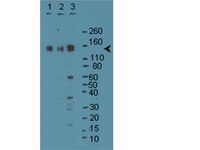MET receptor tyrosine kinase controls dendritic complexity, spine morphogenesis, and glutamatergic synapse maturation in the hippocampus.
Qiu, S; Lu, Z; Levitt, P
The Journal of neuroscience : the official journal of the Society for Neuroscience
34
16166-79
2014
Show Abstract
The MET receptor tyrosine kinase (RTK), implicated in risk for autism spectrum disorder (ASD) and in functional and structural circuit integrity in humans, is a temporally and spatially regulated receptor enriched in dorsal pallial-derived structures during mouse forebrain development. Here we report that loss or gain of function of MET in vitro or in vivo leads to changes, opposite in nature, in dendritic complexity, spine morphogenesis, and the timing of glutamatergic synapse maturation onto hippocampus CA1 neurons. Consistent with the morphological and biochemical changes, deletion of Met in mutant mice results in precocious maturation of excitatory synapse, as indicated by a reduction of the proportion of silent synapses, a faster GluN2A subunit switch, and an enhanced acquisition of AMPA receptors at synaptic sites. Thus, MET-mediated signaling appears to serve as a mechanism for controlling the timing of neuronal growth and functional maturation. These studies suggest that mistimed maturation of glutamatergic synapses leads to the aberrant neural circuits that may be associated with ASD risk. | Immunohistochemistry | 25471559
 |
SynGAP isoforms exert opposing effects on synaptic strength.
McMahon, AC; Barnett, MW; O'Leary, TS; Stoney, PN; Collins, MO; Papadia, S; Choudhary, JS; Komiyama, NH; Grant, SG; Hardingham, GE; Wyllie, DJ; Kind, PC
Nature communications
3
900
2012
Show Abstract
Alternative promoter usage and alternative splicing enable diversification of the transcriptome. Here we demonstrate that the function of Synaptic GTPase-Activating Protein (SynGAP), a key synaptic protein, is determined by the combination of its amino-terminal sequence with its carboxy-terminal sequence. 5' rapid amplification of cDNA ends and primer extension show that different N-terminal protein sequences arise through alternative promoter usage that are regulated by synaptic activity and postnatal age. Heterogeneity in C-terminal protein sequence arises through alternative splicing. Overexpression of SynGAP α1 versus α2 C-termini-containing proteins in hippocampal neurons has opposing effects on synaptic strength, decreasing and increasing miniature excitatory synaptic currents amplitude/frequency, respectively. The magnitude of this C-terminal-dependent effect is modulated by the N-terminal peptide sequence. This is the first demonstration that activity-dependent alternative promoter usage can change the function of a synaptic protein at excitatory synapses. Furthermore, the direction and degree of synaptic modulation exerted by different protein isoforms from a single gene locus is dependent on the combination of differential promoter usage and alternative splicing. | Western Blotting | 22692543
 |
Characterization of a novel synGAP isoform, synGAP-beta.
Li, W; Okano, A; Tian, QB; Nakayama, K; Furihata, T; Nawa, H; Suzuki, T
The Journal of biological chemistry
276
21417-24
2001
Show Abstract
We cloned a cDNA encoding a novel synGAP, synGAP-d (GenBank(TM) accession number ), from a rat brain cDNA library. The clone consisted of 4801 nucleotides with a coding sequence of 3501 nucleotides, encoded a protein consisting of 1166 amino acids with greater than 99% homology with 1092 amino acid overlaps to synGAP, and contained a 13-nucleotide insertion to the previously reported synGAP mRNAs, which suggested that the clone was a splice variant of synGAP. We also found that there are at least seven variants in the 3' portion of the synGAP mRNA and that they encoded five different protein isoforms. The coding sequence of these C-terminal variants were classified into alpha1, alpha2, beta1, beta2, beta3, beta4, and gamma, and synGAP-d was classified as the beta1 form. The previously reported synGAPs (synGAP-a, -b, and -c and p135synGAP) can be classified as the alpha1 isoform. All isoforms were expressed specifically in the brain. Unexpectedly, the beta isoform, which lacks a C-terminal PSD-95-binding motif ((S/T)XV), was more restricted to the postsynaptic density fraction than the motif-containing alpha1 isoform. The beta isoform did not interact with PSD-95 but specifically interacted with a nonphosphorylated alpha subunit of Ca(2+)/calmodulin-dependent protein kinase II through its unique C-terminal tail. | | 11278737
 |











